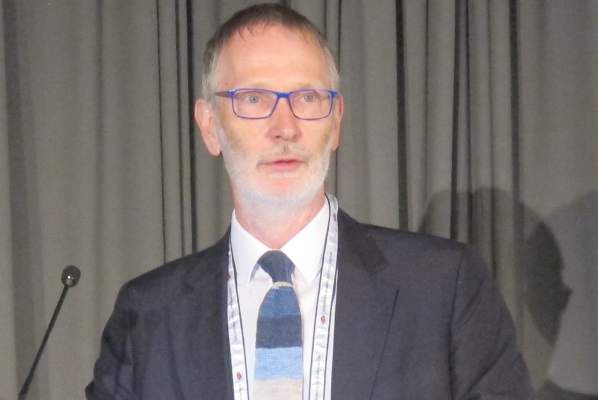At THE EHA CONGRESS
Copenhagen (FRONTLINE MEDICAL NEWS) – Relapse of acute myeloid leukemia among older adults may be caused by pre-leukemic stem cells lurking after treatment.
Among 107 adults with AML treated in a German multicenter clinical trial, 36% were found to have pre-treatment mutations that persisted after therapy, reported Dr. Klaus Metzeler of the University of Munich.
“Mutation persistence after chemotherapy was way more common in older patients, and importantly, patients with persisting mutations had a significantly higher risk of AML recurrence,” he said at a briefing prior to presentation of the data at the annual congress of the European Hematology Association.
The higher relapse risk associated with persistent mutations remained even after adjustment for patient age, cytogenetics, and other risk factors, he noted.
AML can arise from a clone of pre-leukemic stem cells, and it is known that pre-leukemic clones carry genetic mutations that can later be found in leukemic cells. The investigators hypothesized that pre-leukemic clones persisting after chemotherapy could be related treatment outcomes and survival.
To test this idea, they analyzed samples collected from bone marrow or peripheral blood of 107 adults with AML (median age 53 years, range 20-80 years) both before chemotherapy and during the first remission. The majority of remission samples (92%) were collected within the first 180 days of remission.
The investigators looked for the presence of 68 genes known to be recurrently mutated in myeloid malignancies, and identified any sequence alterations with a variant allele frequency of 2% or greater as either known or possible driver mutations, variants of unknown significance, or known germline polymorphisms.
A total of 426 driver mutations in 42 genes were detected in samples collected at diagnosis. In all, 69 patients (64%) had no mutations following chemotherapy. Among the remaining 38 patients, there were 66 persistent mutations in 15 genes. The most common persistent mutations were in the genes DNMT3A, TET2, SRF2, and ASXL1.
“Those are precisely those mutations that are known to occur in these pre-leukemic clones,” Dr. Metzeler said.
Mutations found in the pre-treatment but not the remission samples included those in NMP1, FLT3, WT1, and NRAS.
As noted, patients with one or more persistent mutations tended to be older than those with no mutations, with a median age of 63 years vs. 48 years (P less than .001). Persistence of one or more driver mutations in remission was associated with both significantly shorter relapse-free survival (median 14.3 months vs. 58.0 months, P = .009) and shorter overall survival (median, 39.6 months vs. more than 72 months; P = .005).
In multivariate analyses controlling for age, European LeukemiaNet genetic risk groups, and remission status (complete remission vs. complete remission with incomplete recovery of counts), any persistent mutations was associated with significantly worse relapse-free survival (hazard ratio, 2.2, P =.02) and overall survival (HR, 3.0, P = .008).
“It is well known that older AML patients have a poor prognosis, but the reasons for that aren’t fully understood yet. So the hypothesis that would come from our data is that frequent persistence of pre-leukemic clones may be one potential explanation for the higher relapse risk that we found in older patients,” Dr. Metzeler said.
Asked how clinicians might go about targeting the escaped mutations, Dr. Metzeler noted that the incidence of pre-leukemic somatic mutations among healthy 70-year-olds is about 10%.
“So the challenge will be to identify those patients who will actually relapse, and then an option in fit patients would be an allogeneic transplant. We don’t have targeted agents at the moment where we can target these specific mutations, and it would be relatively hard to justify giving those patients additional chemotherapy at this point,” he said.
“What this is showing for the first time is a clue as to why a subset will relapse, and now we know that this group exists with these pre-leukemic clones, we can begin to ask questions about why it is they relapse or don’t relapse. Is it something to do with the immune system in those patients who don’t relapse?” commented EHA president Tony Green, M.D., who was not involved in the study, but attended the briefing. Dr. Green is a professor in the department of hematology at the Cambridge Stem Cell Institute, University of Cambridge, U.K.
The study was funded by European Hematology Association research fellowships. Dr. Metzeler and Dr. Green reported no relevant disclosures.



